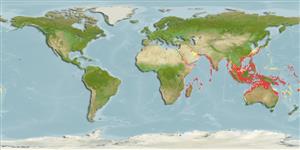>
Holocentriformes (Squirrelfishes, soldierfishes) >
Holocentridae (Squirrelfishes, soldierfishes) > Holocentrinae
Etymology: Sargocentron: Greek, sargos = sargus + Greek, kentron = sting (Ref. 45335).
More on author: Forsskål.
Environment: milieu / climate zone / depth range / distribution range
Ökologie
seewasser riff-verbunden; tiefenbereich 1 - 84 m (Ref. 27370). Subtropical; 35°N - 35°S, 32°E - 173°W (Ref. 27370)
Indo-West Pacific: Red Sea to the western Pacific where it ranges from southern Japan to New Caledonia, Vanuatu and New South Wales, Australia. Recently recorded from Tonga (Ref. 53797). Not yet recorded from any oceanic island in the western Indian Ocean. Invaded eastern Mediterranean via the Suez Canal.
Length at first maturity / Size / Gewicht / Alter
Maturity: Lm 14.7 range ? - ? cm
Max length : 32.0 cm TL Männchen/unbestimmt; (Ref. 5213); common length : 27.0 cm TL Männchen/unbestimmt; (Ref. 43448)
Rückenflossenstacheln (insgesamt) : 11; Rückenflossenweichstrahlen (insgesamt) : 12 - 14; Afterflossenstacheln: 4; Afterflossenweichstrahlen: 8 - 10. Body with subequal stripes of brownish red and silvery white; spinous dorsal dark red with a large, quadrangular, whitish blotch in middle of each membrane (except the first) forming a median band; dorsal membrane tips white, except posteriorly (Ref. 4201). Five oblique scale rows on cheek; body depth 2.5-2.8 in SL; head length (HL) 2.65-2.85 in SL; short and blunt snout, its length 4.25-4.7 in HL; interorbital width 4.5 in HL; mouth terminal to slightly inferior, maxilla usually extending nearly to or a short distance beyond a vertical through center of eye, upper jaw length 2.5-2.75 in HL; premaxillary groove often ending above anterior edge of orbit; anterior end of nasal bone with a blunt spine; surface or medial edge of nasal bone spineless; nasal fossa usually without spinules on its edge; upper edge of 1st suborbital bone with a slightly retrorse lateral spine a short distance posterior to a vertical at front edge of eye, followed by a ridge of recumbent spinules; preopercular spine usually about 2/3 orbit diameter, 3.2-5.3 in HL; 3rd-5th dorsal spines subequal, longest in adults 1.9-2.3 in HL; 3rd anal spine 1.35-1.6 in HL (Ref. 27370).
Found in coastal reefs (Ref. 9710); silty reefs or wrecks in lagoons, bays, or harbors (Ref. 27370), may occur in aggregations; also found hidden in caves and cracks of rocks during the day (Ref. 12382, 48635), usually in areas subject to strong currents (Ref. 48635). Intertidal observations were also reported (Ref. 49162). Feed mainly on benthic crabs and shrimps (Ref. 2334), also preys on small fishes (Ref. 12382). Eggs and larvae are pelagic (Ref. 6746). Spine of preopercle venomous (Ref. 2334). Solitary or in groups (Ref 90102).
Randall, J.E., 1998. Revision of the Indo-Pacific squirrelfishes (Beryciformes: Holocentridae: Holocentrinae) of the genus Sargocentron, with descriptions of four new species. Indo-Pac. Fish. (27):105 p. (Ref. 27370)
IUCN Rote Liste Status (Ref. 130435)
Nutzung durch Menschen
Fischereien: weniger kommerziell; Aquarium: Öffentliche Aquarien
Tools
Zusatzinformationen
Download XML
Internet Quellen
Estimates based on models
Preferred temperature (Ref.
123201): 25 - 29, mean 28.1 °C (based on 1372 cells).
Phylogenetic diversity index (Ref.
82804): PD
50 = 0.5000 [Uniqueness, from 0.5 = low to 2.0 = high].
Bayesian length-weight: a=0.01738 (0.01406 - 0.02148), b=2.97 (2.92 - 3.02), in cm total length, based on LWR estimates for this species (Ref.
93245).
Trophic level (Ref.
69278): 3.6 ±0.3 se; based on diet studies.
Widerstandsfähigkeit (Ref.
120179): hoch, Verdopplung der Population dauert weniger als 15 Monate. (Preliminary K or Fecundity.).
Fishing Vulnerability (Ref.
59153): Low vulnerability (17 of 100).
Nutrients (Ref.
124155): Calcium = 37.1 [12.8, 126.2] mg/100g; Iron = 0.583 [0.214, 1.854] mg/100g; Protein = 19.5 [18.2, 20.7] %; Omega3 = 0.234 [0.086, 0.593] g/100g; Selenium = 22.1 [10.4, 47.6] μg/100g; VitaminA = 26.4 [8.1, 94.8] μg/100g; Zinc = 1.15 [0.45, 2.29] mg/100g (wet weight);
